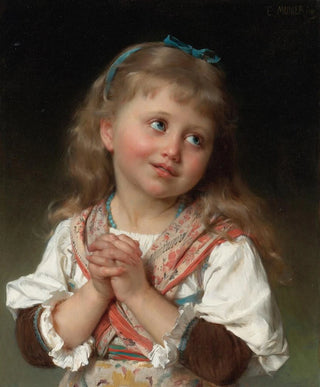Art print | May I - Émile Munier


View from behind

Frame (optional)
Can I - Émile Munier – Captivating Introduction
In the fascinating universe of art, some works manage to transcend time and capture the very essence of humanity. "Can I" by Émile Munier is one of those creations that, through its delicacy and expressiveness, invites us to deep contemplation. This canvas, imbued with poetry, evokes a suspended moment where human emotions reveal themselves in all their intensity. Through this piece, Munier offers us a glimpse into vulnerability and the beauty of human relationships, immersing us in a universe where every detail matters and every gesture tells a story.
Style and uniqueness of the work
Émile Munier's style is distinguished by remarkable technical mastery and a sensitivity that is palpable. In "Can I," delicate nuances of the palette blend harmoniously, creating an intimate atmosphere that envelops the viewer. The characters, skillfully rendered, possess a striking expressiveness that reveals their thoughts and feelings. The artist excels in rendering textures, whether the softness of clothing or the luminosity of skin; each element is carefully observed and transcribed. This attention to detail gives the work an almost tactile dimension, inviting the viewer to approach and immerse themselves in the frozen moment captured by Munier. The composition, meanwhile, is balanced, highlighting the protagonists while hinting at a background that, although discreet, contributes to the visual storytelling.
The artist and his influence
Émile Munier, a French painter of the 19th century, is often associated with the academic movement, but his work goes far beyond the conventions of his time. Trained at the École des Beaux-Arts, he developed a personal style that combines realism and romanticism. Munier draws inspiration from the masters of the past while infusing his own vision, allowing him to create works that still resonate today. His influence is felt among many contemporary artists, who admire his ability to capture human emotion with such finesse. Through "Can I," he reminds us that art is primarily an exploration of feelings, a quest for connection between beings. His legacy endures, and his work continues to inspire.

Matte finish

View from behind

Frame (optional)
Can I - Émile Munier – Captivating Introduction
In the fascinating universe of art, some works manage to transcend time and capture the very essence of humanity. "Can I" by Émile Munier is one of those creations that, through its delicacy and expressiveness, invites us to deep contemplation. This canvas, imbued with poetry, evokes a suspended moment where human emotions reveal themselves in all their intensity. Through this piece, Munier offers us a glimpse into vulnerability and the beauty of human relationships, immersing us in a universe where every detail matters and every gesture tells a story.
Style and uniqueness of the work
Émile Munier's style is distinguished by remarkable technical mastery and a sensitivity that is palpable. In "Can I," delicate nuances of the palette blend harmoniously, creating an intimate atmosphere that envelops the viewer. The characters, skillfully rendered, possess a striking expressiveness that reveals their thoughts and feelings. The artist excels in rendering textures, whether the softness of clothing or the luminosity of skin; each element is carefully observed and transcribed. This attention to detail gives the work an almost tactile dimension, inviting the viewer to approach and immerse themselves in the frozen moment captured by Munier. The composition, meanwhile, is balanced, highlighting the protagonists while hinting at a background that, although discreet, contributes to the visual storytelling.
The artist and his influence
Émile Munier, a French painter of the 19th century, is often associated with the academic movement, but his work goes far beyond the conventions of his time. Trained at the École des Beaux-Arts, he developed a personal style that combines realism and romanticism. Munier draws inspiration from the masters of the past while infusing his own vision, allowing him to create works that still resonate today. His influence is felt among many contemporary artists, who admire his ability to capture human emotion with such finesse. Through "Can I," he reminds us that art is primarily an exploration of feelings, a quest for connection between beings. His legacy endures, and his work continues to inspire.






